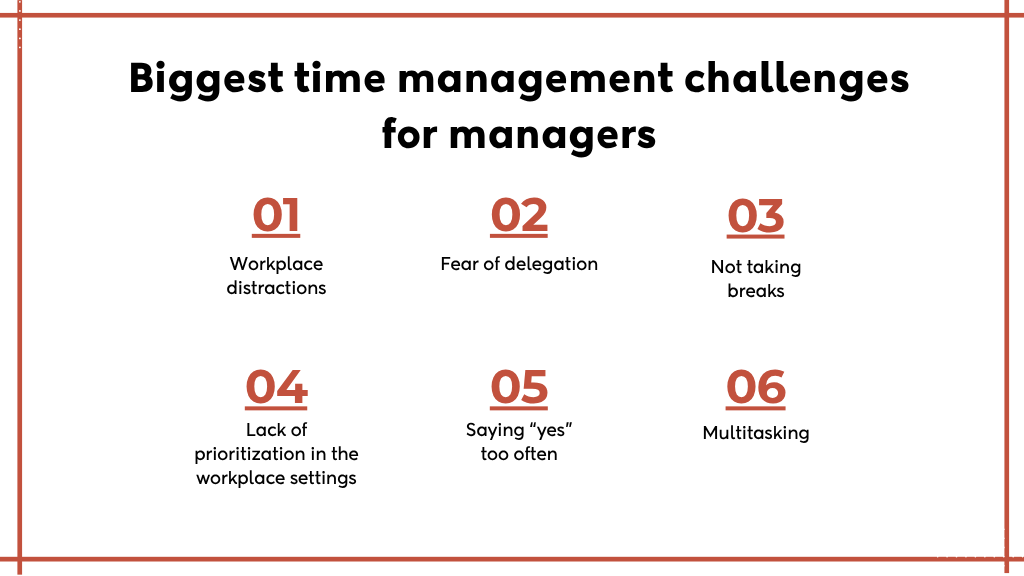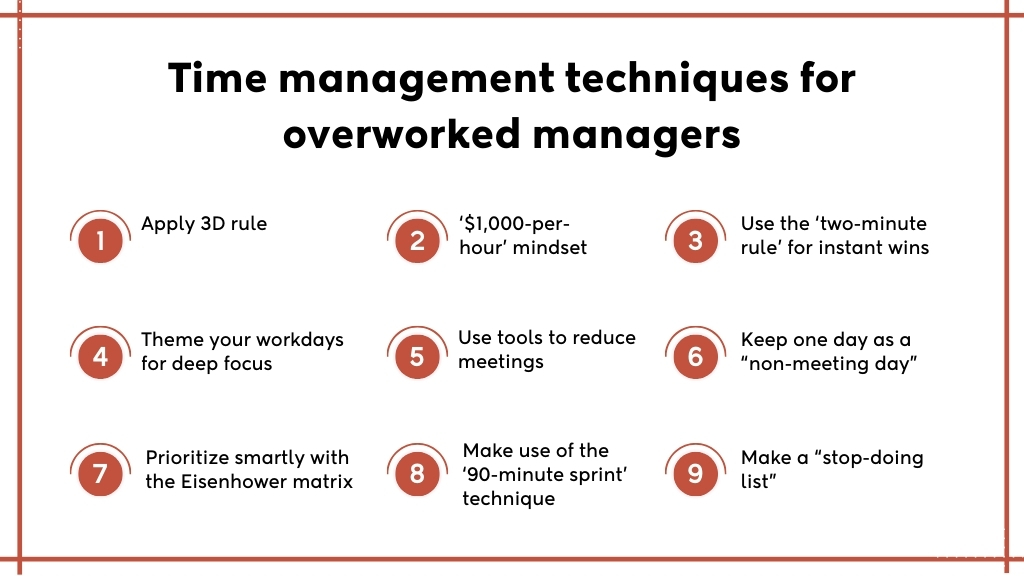Feeling like you’re constantly putting out fires instead of leading?
As a manager, your day is filled with meetings, endless emails, and guiding your team. But without strategic time management, staying productive and sane—becomes a challenge. However, finding time for high-impact work and staying more productive can only be achieved through time management techniques.
Time management is a crucial skill for managers; without it, stress rises, deadlines slip, and productivity suffers. In this article, you will explore practical tips to regain control of your time.
6 Time management challenges faced by managers
Effective time management is key to maintaining work-life balance, but it comes with a fair share of challenges. Managers often struggle with:

- Workplace distractions: Escaping from workplace distractions is a major challenge for managers. They can occur from constant interruptions from team members, noise in the workplace, or pop-up notifications from emails and messages.
- Fear of delegation: It is one of the common challenges that managers face. Most professionals like to complete tasks independently, but delegation is essential when a lot of tasks pile up.
- Not taking breaks: Taking breaks seems counterproductive, but in reality, it is downtime that will keep you recharged. As a manager, you have a lot of responsibilities; sometimes, taking time for yourself can be challenging, but it will help you perform quality work.
- Lack of prioritization in the workplace settings: This is another significant challenge that managers struggle with. It leads to inefficiency, missed deadlines, and overwhelmed teams as managers struggle to allocate resources and focus on what’s important.
- Saying ‘yes’ too often: If you are constantly saying ‘yes’ to new things, you can get overwhelmed easily by the increased workload. The tasks and responsibilities you have will suffer eventually.
- Multitasking: Multitasking may seem efficient to managers, but it significantly reduces productivity, increases errors, and distracts focus. It leads to less work completion.
9 Time management techniques for overworked managers

As a manager, your role is to keep tasks on track, minimize procrastination, and drive better decision-making. However, with so much to oversee, the real challenge is managing it all within the limited time. That’s where time management strategies come to the rescue.
1. Apply 3D rule
The 3D rule is one of the popular time management techniques among managers. The three D’s stand for “Do it,” “Drop it,” and “Delegate it.” It helps managers streamline tasks and improve efficiency.
Here’s how it works
- Do It: If a task is urgent, important, and can be completed quickly, handle it immediately.
- Drop It: If the task is neither important nor urgent, drop it.
- Delegate It: If the task can be done by someone else effectively, assign it to a capable team member.
Leadership is the art of getting someone else to do something you want done because he wants to do it. — Dwight D. Eisenhower
2. ‘$1,000-per-hour’ mindset
The “$1,000-per-hour” mindset is a strategy that helps managers prioritize high-value tasks and eliminate low-impact activities. The concept is simple: treat your time as if every hour is worth $1,000, so you can focus on high-impact work.
How managers can apply it
- Identify high-value tasks: You must focus on strategic decisions, business growth, leadership, and problem-solving instead of admin work. Eliminate distractions and low-value work.
- Delegate effectively: Assign tasks that others can handle, freeing up time for important work.
- Set boundaries: Protect your time by saying “no” to low-priority work.
3. Use the ‘two-minute rule’ for instant wins
This rule states that if a task can be completed in 2 minutes or less, you must do it immediately.
How to use this rule
Clear small tasks instantly: Reply to quick emails, approve requests, or give short feedback on projects.
Prevent small tasks from piling up: Small tasks pile up when postponed; handling them immediately keeps your workload manageable.
4. Theme your workdays for deep focus
This technique is highly effective for managers who are struggling with time management. Assigning themes to each day of the week will ensure deep work on high-priority tasks without constant switching.
How to implement theme workdays
- Assign themes to each day: Dedicate specific days to different types of work. For example:
- Monday: Strategic Planning & Goal Setting
- Tuesday: Team Meetings
- Club similar tasks: Batching similar tasks improves workflow and helps maintain a long-term focus on key priorities.
5. Use tools to reduce meetings
Productivity tools can help managers eliminate unnecessary meetings and boost efficiency. Use project management platforms with time tracking, communication channels, and task assignment features—such as ProofHub, Asana, Wrike, Basecamp & Trello—to plan your day.
6. Keep one day as a “non-meeting day”
According to Forbes, leaders spend 72% of week in meetings. Keeping a day as a non-meeting day in a week can help you focus on high-priority tasks, save time, and enhance your productivity.
How to implement it
- Choose the right day thoughtfully: Picking a day that minimizes workflow disruptions and aligns with your team’s heavy schedules.
- Set clear expectations: Define what a non-meeting day means—no internal meetings and minimal client calls. Make exceptions only for urgent matters and encourage alternative ways to share updates.
- Communicate the changes: Announce the non-meeting day through a team meeting or email, clearly explaining its purpose and guidelines.
7. Prioritize smartly with the Eisenhower matrix
It is a technique that will help managers use their time effectively. The method divides work into four quadrants:
- Urgent & Important (do immediately)
- Important but Not Urgent (schedule for later)
- Urgent but Not Important (delegate)
- Neither Urgent nor Important (eliminate).
This strategy ensures that managers are focusing on what’s important with deep focus.
How to implement it
- List your tasks: Write down all your daily or weekly tasks.
- Categorize them: Place each task into one of the four quadrants.
- Act accordingly: Focus on Quadrants 1 & 2, delegate Quadrant 3, and eliminate Quadrant 4.
- Review & adjust: Regularly reassess priorities to stay on track.
8. Make use of the ‘90-minute sprint’ technique
This is an excellent productivity-driven strategy for managers who are looking to save time. You have to work for 90 minutes straight, followed by a break. These techniques help in maximizing focus and productivity during concentrated work periods.
How to implement it
- Take one task at a time: One task at a time will help you focus deeply and complete the task efficiently.
- Eliminate distractions: Don’t check your phone, e-mail, or anything for 90 minutes; keep your concentration solely on the task at hand.
- Take Breaks: Take regular breaks for 20-30 minutes after each sprint.
- Timer: Use a timer to track it.
- Schedule: Make sure your sprint aligns with your peak energy times.
9. Make a “stop-doing list”
Along with a to-do list, managers should create a stop-doing list to identify tasks that waste time. This helps eliminate low-value tasks and refocuses on priorities
How to implement it
- Identify low-value activities: Review your tasks and pinpoint what’s consuming time without adding real impact—unnecessary meetings, micromanagement, or admin work.
- Categorize what to stop doing: Sort tasks into delegate, automate, eliminate, or reduce to free up time for strategic leadership.
- Set boundaries & communicate: Clearly define what you’re stepping away from, delegate effectively, and ensure your team understands the shift.
- Regularly review & adjust: Revisit your “stop doing list” periodically to refine it based on evolving priorities and team capabilities.
Bottomline
To conclude, time management is crucial for managers to reduce stress, increase efficiency, and productivity. Overwhelmed managers can’t guide their teams and solve their problems, which eventually takes the organization away from the path of growth and success. Using time management techniques like 3-D rule, theming workdays, using tools to delegatetasks,s and communicating can help managers to boost productivity, take control of their schedules, and lead teams effectively.



























No Comments